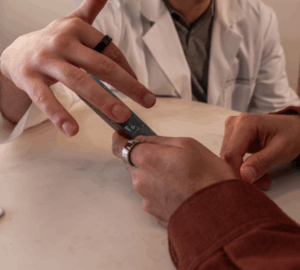Oura’s Fertile Window feature provides reliable insights into members’ fertile days, helping people who are trying to conceive or learn more about their bodies. As with any Oura feature, the algorithm powering Fertile Window was developed and validated through extensive testing and scientific research.
In a study recently published in The Journal of Medical Internet Research (JMIR), researchers determined that Oura’s “physiology method demonstrated superior accuracy over the calendar method, with approximately 3-fold improvement.”
The study, titled “Oura Ring as a Tool for Ovulation Detection: Validation Analysis,” was authored by Nina Thigpen, PhD, former Science Lead for Women’s Health at Oura; Shyamal Patel, PhD, SVP, Science, at Oura; and Xi Zhang, VP, Health Sensing at Oura.
The researchers made sure to include women with irregular cycles in their research.
“We prioritized designing an algorithm that works for everyone, including individuals with irregular cycles, as they often encounter the biggest hurdles with existing solutions,” Zhang says. “Developing algorithms for irregular cycles is more challenging, but it’s also where the impact can be most significant. Our goal was to rigorously evaluate the strengths and limitations of our physiology algorithm across a diverse population, considering variations in age, cycle length, and cycle patterns.”
READ MORE: How Oura Data Can Help You Understand Your Menstrual Cycle
Key Findings
- Oura Ring detected 96.4% of ovulations with an average error of ±1.26 days. This method was significantly more precise than the calendar method, which exhibited an average error of ±3.44 days.
- Oura Ring was significantly more accurate across all cycle lengths, cycle variability groups, and age groups than the calendar method.
- Oura Ring demonstrated strong accuracy for irregular cycles.
- 82% of estimations using Oura Ring were within 2 days of the reference ovulation date, whereas 32.5% of estimations using the calendar method were within 2 days of the reference ovulation date for individuals with irregular cycles.
Find the full study here.
Study Design
Study Participants
The study included data from 1,155 ovulatory menstrual cycles gathered from 964 deidentified and anonymized Oura members. Participants were selected based on their use of ovulation prediction kits (OPKs), meaning that these members had previously tagged “positive luteinizing hormone (LH) test” on the Oura App. This data was used to compare the accuracy of the ovulation detection methods.
To be included in the study, participants had to have a full menstrual cycle with reported start and end dates of their period and a positive LH test result that indicated the ovulation date.
Methodology
The study compared two methods for detecting ovulation:
- Physiology Method (Oura Ring): This method used continuous data collected by Oura Ring, specifically from finger temperature readings. The Oura algorithm detects a sustained rise in skin temperature, which occurs after ovulation due to the hormonal changes associated with the luteal phase. The algorithm uses signal processing techniques to normalize the temperature data, filter out noise, and identify ovulation events.
- Calendar Method: This traditional method estimates ovulation by subtracting the typical luteal phase length from the average menstrual cycle length, based on the individual’s last period start date.
The study sample was divided into subgroups based on cycle length, cycle variability, and age to assess the performance of each method in different demographic groups.
Discussion
Tracking physiological changes with Oura Ring outperformed the traditional calendar method across the board, regardless of age, cycle length, or variability, confirming its potential as a reliable tool for ovulation detection.
The accuracy of Oura Ring was particularly notable in members with irregular cycles. While the calendar method struggled, producing an average error of 6.63 days for irregular cyclers, the physiology method remained much more consistent, with an error of just 1.48 days. This difference highlights the ability of Oura Ring to track ovulation more precisely, especially in cases where traditional methods are prone to errors due to variations in cycle length or timing.
This research successfully validates the accuracy of Oura’s Fertile Window algorithm, confirming its ability to reliably estimate ovulation dates and track the fertile window. By validating the algorithm with real-world data, this research opens the door for a more accurate and accessible way to track fertility, whether for conception or greater body literacy.
“This algorithm helps individuals trying to conceive by precisely detecting their fertile window, even for those with irregular cycles,” Zhang says.
“We’re proud that our results show it outperforms traditional calendar methods and manual tracking like basal body temperature, offering a seamless way to monitor fertility and reproductive health.”
RELATED: What Happens to Your Body During Pregnancy, According to Oura Member Data










